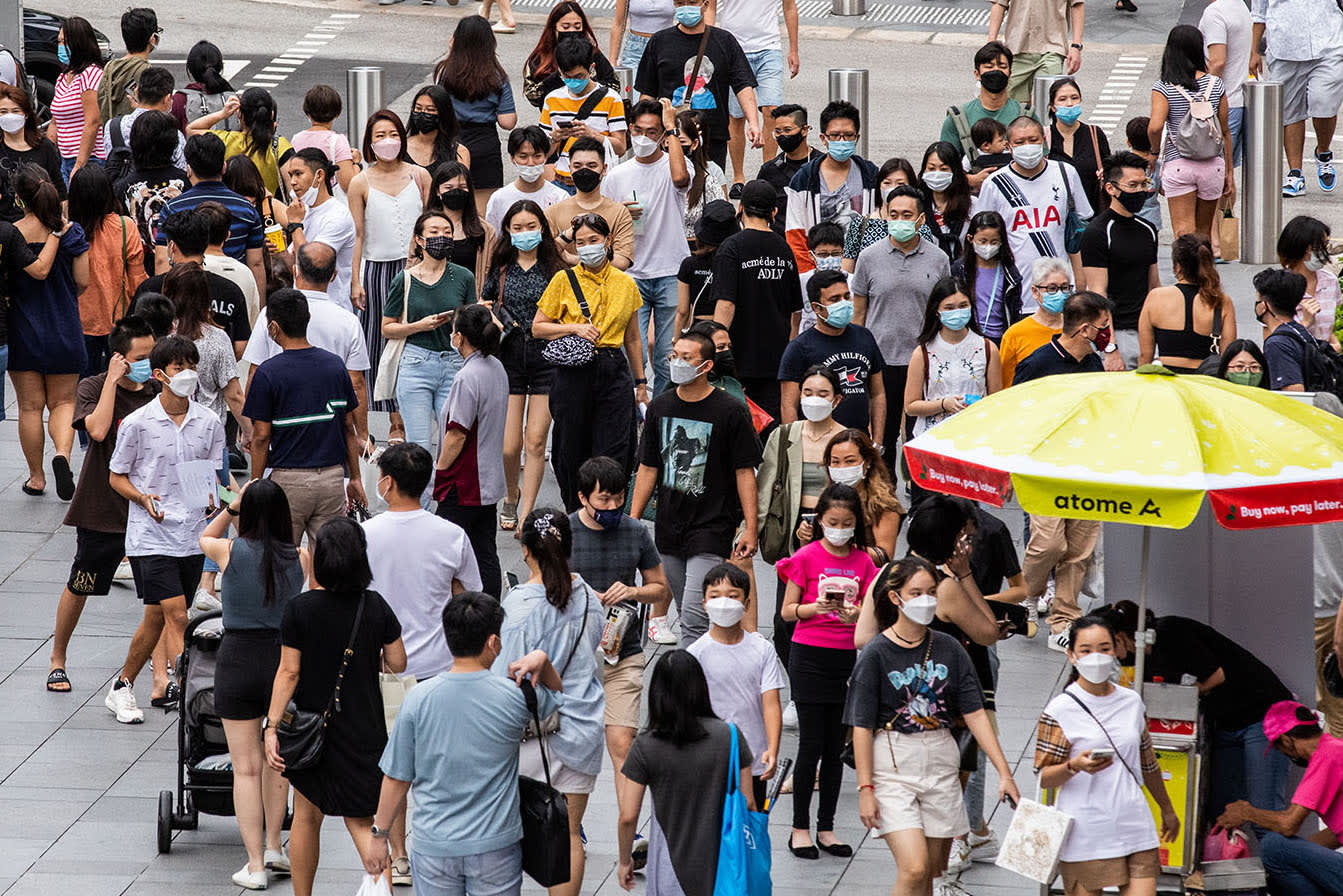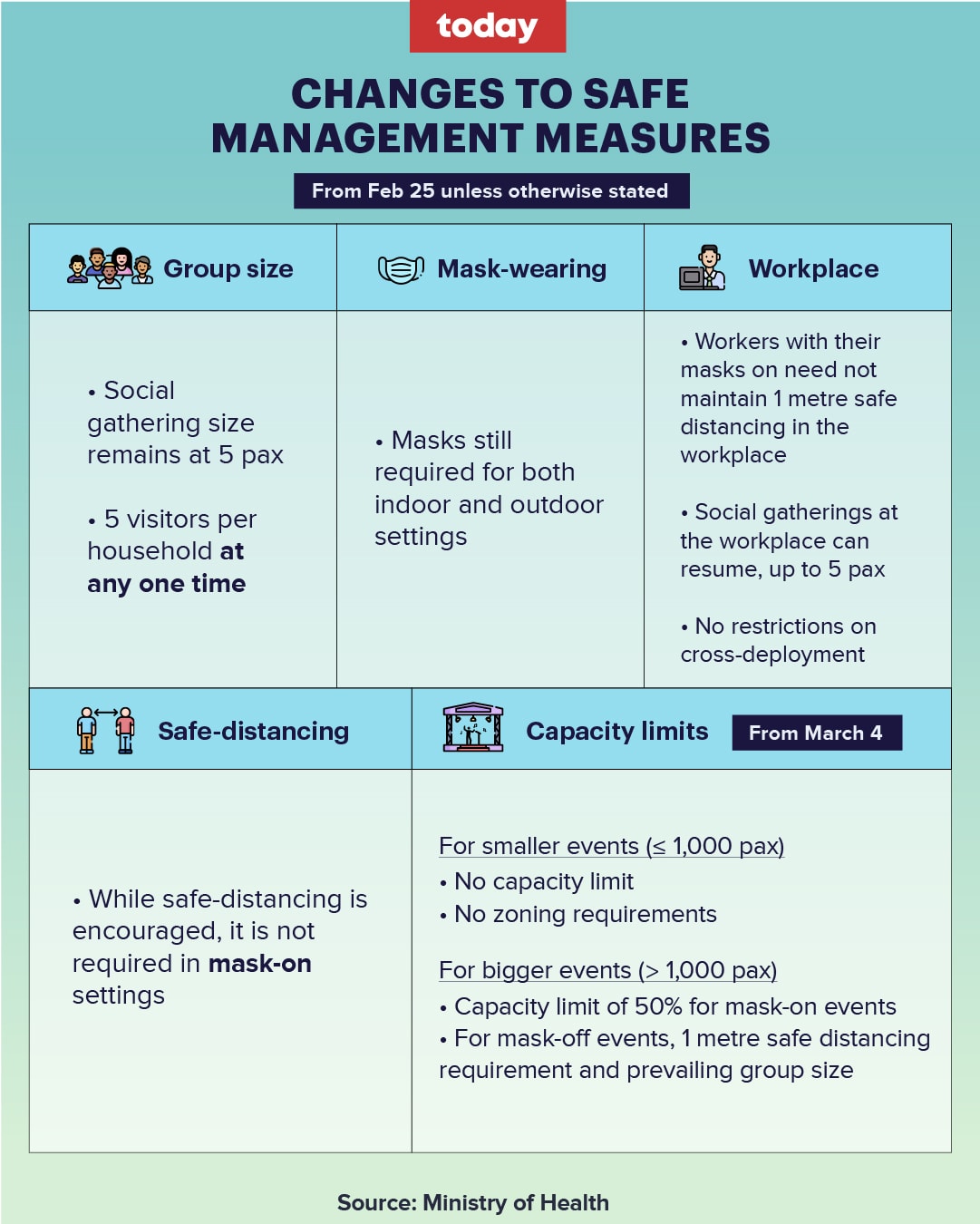- Joined
- Apr 14, 2011
- Messages
- 20,143
- Points
- 113
Safe distancing no longer required when masks are on from Feb 25; household visitors cap eased to 5 at any time

- The updated rules will apply to group sizes, mask wearing, workplace requirements, safe distancing and event capacity limits
- They will take effect from Feb 25
- MOH said they are being changed to make them simpler to understand and comply with
- Rostered Routine Testing regimes will also only apply to those working in settings catering to the vulnerable

BY
LOW YOUJIN
Published February 16, 2022Updated February 16, 2022
WhatsAppTelegramFacebookTwitterEmailLinkedIn
SINGAPORE — From next Friday (Feb 25), the maximum number of unique visitors per household will be adjusted from five persons per day to five persons at any one time.
Safe distancing will also no longer be required between individuals or groups when they have their masks on, including in the workplace.
ADVERTISEMENT
The Ministry of Health (MOH) said this on Wednesday as it announced an update on current Covid-19 rules to make them “simpler to understand and comply with”.
The ministry said the updated rules, which will come into effect from Feb 25, will be focusing on five measures which it described as the most “important and effective”.
The other changes are:
Group sizes
MOH said that the permissible group size for social gatherings remains at five individuals.
ADVERTISEMENT
Mask-wearing
There will be no changes to mask wearing, and it will continue to be required as a default.
Workplace requirements
In the workplace, employees who have their masks on will no longer need to maintain the 1m safe distancing rule.
MOH said it will not change the current posture of allowing up to 50 per cent of employees who can work from home to return to the office.
ADVERTISEMENT
Social gatherings at workplaces will also be allowed to resume with up to five persons for each social gathering.
Furthermore, there will be no restrictions on cross-deployment of employees across workplaces, although MOH said employers “may continue to do so for business continuity reasons”.
Safe-distancing
Safe distancing will continue to be encouraged, but will not be required between individuals or groups in all mask-on settings, said MOH.
However, safe distancing will continue to be required for all mask-off settings.
ADVERTISEMENT
Where safe distancing is required, MOH said the distance will be streamlined to a single safe distance of 1m for all settings.
Capacity limits
As for events, MOH said it will no longer be fixing size limits for various event types.
Rather, it will set event sizes based on the capacity of the venue.
As such, MOH said it will be lifting specific event size limits for events such as religious services, business events, media conferences, funerary memorial events, wedding receptions and mask-on classes from March 4.
Zoning requirements will also be removed, since the main protection is through masks and vaccinations, said MOH.
Nevertheless, for large events and settings which pose more infection risks, the authorities will still impose capacity limits as a precaution.
These will include attractions, cruises, meetings, incentives, conferences and exhibitions (Mice), and large work-related events, as well as large performing arts venues or sports stadiums.
For other settings such as shopping malls and large standalone stores, the current density limit of 10 square metres per person roughly translates to a 50 per cent capacity, too.
Therefore, the ministry said it will set a threshold of 1,000 individuals in such a scenario.
What this means is that for smaller settings or events with 1,000 individuals or fewer, they can proceed without being subject to any capacity limit.
Otherwise, for larger settings or events with more than 1,000 masked individuals, they will be subject to a capacity limit of 50 per cent.
In the event they are not wearing their masks, they will be required to comply with the 1m safe distancing requirement and prevailing group size. This, said MOH, will already serve to limit capacity.
Speaking during a press conference by the multi-ministry Covid-19 taskforce, Health Minister Ong Ye Kung said that with the new rules, the Government will "no longer forbid practices that actually do not make a material difference to the pandemic, but which we are observing very strictly".
For instance, as long as people are masked, there is no longer a need to allow only alternate seats at park benches, he said.
"Or the urinals in the men's toilets. The men will know sometimes that alternate ones are crossed out, which are not necessary so long as you're wearing your mask."
He said this will also apply to groups of people hoping to take photographs — they will no longer need to stand 1m apart, if they are masked.
"I think all these little things really don't matter anymore and we can do away with them. Our people know we are in a crisis, and we can start to remove these little daily reminders that are not material anymore," said Mr Ong.

STREAMLINING ROSTERED ROUTINE TESTING
The rostered routine testing (RRT) regime, which was first introduced in foreign worker dormitories and higher-risk workplaces in August 2020, will also undergo some changes.
From Friday (Feb 18) onwards, the MOH said that the regime will now focus only on settings catering to vulnerable groups, such as the healthcare and eldercare sector, and with children below the age of five, and selected essential services sectors.
Otherwise, other sectors which are currently on the RRT will regime “no longer be required to continue testing” from Friday onwards.
Explaining the reasons for the change, MOH said the RRT regime had served as an important part of Singapore’s strategy to facilitate early detection and containment of transmission in the community.
While testing continues to be an essential response to Covid-19, MOH said “we are in a different situation today and our testing strategy needs to evolve”.
As it is, the ministry said Singapore’s high vaccination coverage and the implementation of vaccination-differentiated rules offer “good protection to the workforce from severe disease due to Covid-19 infection”.
Moreover, the high transmissibility and shorter incubation period of the Omicron variant have also meant a reduction in the effectiveness of RRT in containing community transmission.
“Furthermore, we have shifted our focus towards protecting the vulnerable population and managing severe cases,” said MOH.




